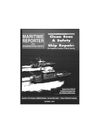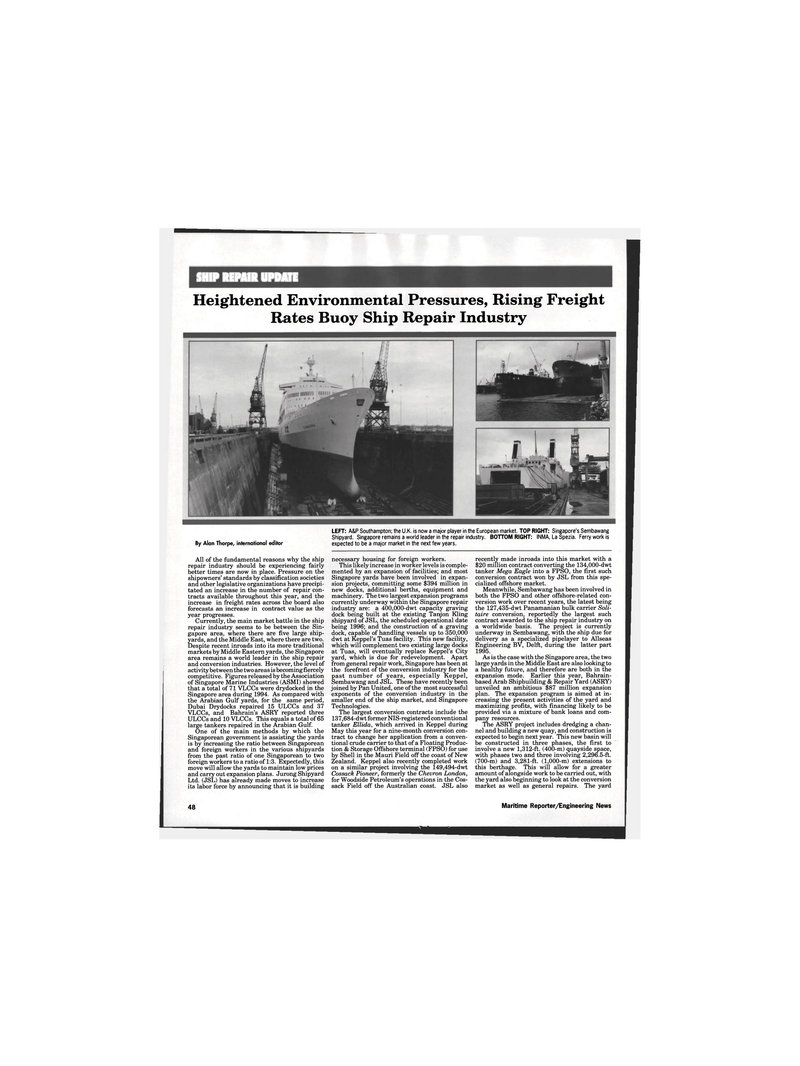
Page 46: of Maritime Reporter Magazine (October 1995)
Read this page in Pdf, Flash or Html5 edition of October 1995 Maritime Reporter Magazine
SHIP REPAIR UPDATE
Heightened Environmental Pressures, Rising Freight
Rates Buoy Ship Repair Industry
By Alan Thorpe, international editor
LEFT: A&P Southampton; the U.K. is now a major player in the European market. TOP RIGHT: Singapore's Sembawang
Shipyard. Singapore remains a world leader in the repair industry. BOTTOM RIGHT: INMA, La Spezia. Ferry work is expected to be a major market in the next few years.
All of the fundamental reasons why the ship repair industry should be experiencing fairly better times are now in place. Pressure on the shipowners' standards by classification societies and other legislative organizations have precipi- tated an increase in the number of repair con- tracts available throughout this year, and the increase in freight rates across the board also forecasts an increase in contract value as the year progresses.
Currently, the main market battle in the ship repair industry seems to be between the Sin- gapore area, where there are five large ship- yards, and the Middle East, where there are two.
Despite recent inroads into its more traditional markets by Middle Eastern yards, the Singapore area remains a world leader in the ship repair and conversion industries. However, the level of activity between the two areas is becoming fiercely competitive. Figures released by the Association of Singapore Marine Industries (ASMI) showed that a total of 71 VLCCs were drydocked in the
Singapore area during 1994. As compared with the Arabian Gulf yards, for the same period,
Dubai Drydocks repaired 15 ULCCs and 37
VLCCs, and Bahrain's ASRY reported three
ULCCs and 10 VLCCs. This equals a total of 65 large tankers repaired in the Arabian Gulf.
One of the main methods by which the
Singaporean government is assisting the yards is by increasing the ratio between Singaporean and foreign workers in the various shipyards from the past ratio of one Singaporean to two foreign workers to a ratio of 1:3. Expectedly, this move will allow the yards to maintain low prices and carry out expansion plans. Jurong Shipyard
Ltd. (JSL) has already made moves to increase its labor force by announcing that it is building necessary housing for foreign workers.
This likely increase in worker levels is comple- mented by an expansion of facilities; and most
Singapore yards have been involved in expan- sion projects, committing some $394 million in new docks, additional berths, equipment and machinery. The two largest expansion programs currently underway within the Singapore repair industry are: a 400,000-dwt capacity graving dock being built at the existing Tanjon Kling shipyard of JSL, the scheduled operational date being 1996; and the construction of a graving dock, capable of handling vessels up to 350,000 dwt at Keppel's Tuas facility. This new facility, which will complement two existing large docks at Tuas, will eventually replace Keppel's City yard, which is due for redevelopment. Apart from general repair work, Singapore has been at the forefront of the conversion industry for the past number of years, especially Keppel,
Sembawang and JSL. These have recently been joined by Pan United, one of the most successful exponents of the conversion industry in the smaller end of the ship market, and Singapore
Technologies.
The largest conversion contracts include the 137,684-dwt former NIS-registered conventional tanker Ellida, which arrived in Keppel during
May this year for a nine-month conversion con- tract to change her application from a conven- tional crude carrier to that of a Floating Produc- tion & Storage Offshore terminal (FPSO) for use by Shell in the Mauri Field off the coast of New
Zealand. Keppel also recently completed work on a similar project involving the 149,494-dwt
Cossack Pioneer, formerly the Chevron London, for Woodside Petroleum's operations in the Cos- sack Field off the Australian coast. JSL also recently made inroads into this market with a $20 million contract converting the 134,000-dwt tanker Mega Eagle into a FPSO, the first such conversion contract won by JSL from this spe- cialized offshore market.
Meanwhile, Sembawang has been involved in both the FPSO and other offshore-related con- version work over recent years, the latest being the 127,435-dwt Panamanian bulk carrier Soli- taire conversion, reportedly the largest such contract awarded to the ship repair industry on a worldwide basis. The project is currently underway in Sembawang, with the ship due for delivery as a specialized pipelayer to Allseas
Engineering BV, Delft, during the latter part 1995.
As is the case with the Singapore area, the two large yards in the Middle East are also looking to a healthy future, and therefore are both in the expansion mode. Earlier this year, Bahrain- based Arab Shipbuilding & Repair Yard (ASRY) unveiled an ambitious $87 million expansion plan. The expansion program is aimed at in- creasing the present activities of the yard and maximizing profits, with financing likely to be provided via a mixture of bank loans and com- pany resources.
The ASRY project includes dredging a chan- nel and building a new quay, and construction is expected to begin next year. This new basin will be constructed in three phases, the first to involve a new 1,312-ft. (400-m) quayside space, with phases two and three involving 2,296.5-ft. (700-m) and 3,281-ft. (1,000-m) extensions to this berthage. This will allow for a greater amount of alongside work to be carried out, with the yard also beginning to look at the conversion market as well as general repairs. The yard 48 Maritime Reporter/Engineering News

 45
45

 47
47
